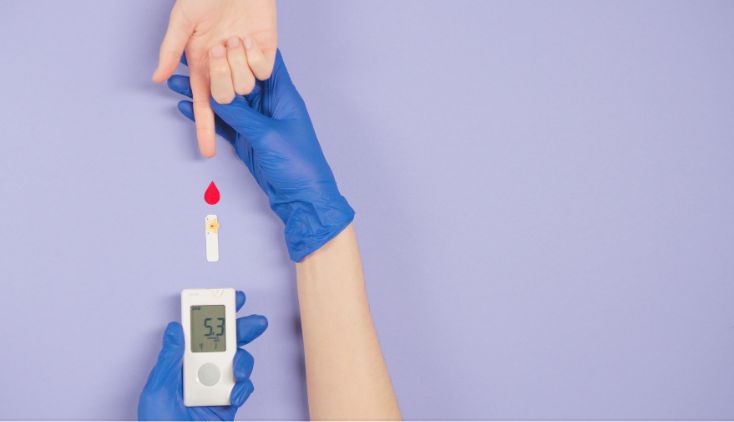How to Recognize the Warning Signs
Identifying early signs of diabetes can help ensure timely diagnosis and effective management. Type 1 and type 2 diabetes have unique traits, though they share certain symptoms. Below, we’ll cover signs specific to each type and end with a section on treatment options.
Signs of Type 1 Diabetes
1. Unexplained Weight Loss
With insufficient insulin to allow glucose into cells, the body breaks down muscle and fat for energy, leading to noticeable weight loss even without changes in diet or physical activity.
2. Increased Hunger (Polyphagia)
Because the body’s cells are deprived of glucose, intense hunger can persist, even after consuming a full meal.
3. Frequent Urination (Polyuria)
Excess glucose in the bloodstream causes the kidneys to filter more fluids, resulting in increased urination, which may disturb sleep.
4. Increased Thirst (Polydipsia)
Frequent urination leads to dehydration, and as a result, people with type 1 diabetes often feel constantly thirsty, needing to drink more water to stay hydrated.
5. Fatigue
Since cells can’t access glucose for energy, people with type 1 diabetes often feel persistently tired, which can affect mood and concentration.
6. Blurred Vision
High blood sugar levels can change fluid levels in the eyes, altering the shape of the lens and causing blurry or unfocused vision.
Signs of Type 2 Diabetes
1. Slow-Healing Wounds
High blood sugar levels can impair blood flow and delay healing, so cuts and bruises may take significantly longer to heal in people with type 2 diabetes.
2. Frequent Infections
The immune system weakens over time with uncontrolled blood sugar, increasing susceptibility to infections, especially of the skin, urinary tract and gums.
3. Numbness or Tingling (Peripheral Neuropathy)
Prolonged high blood sugar levels can cause nerve damage, leading to tingling, numbness or pain, particularly in the hands and feet.
4. Darkened Skin Patches (Acanthosis Nigricans)
Insulin resistance may cause skin to darken in areas like the neck, armpits or groin, resulting in velvety skin patches associated with type 2 diabetes.
5. Blurred Vision
Similar to type 1, high blood sugar levels affect fluid levels in the eyes, altering the lens’s shape and clarity, which can lead to temporary blurred vision.
Shared Symptoms Between Type 1 and Type 2 Diabetes
Although each type of diabetes has unique symptoms, there are overlapping signs that suggest elevated blood sugar, including:
- Increased thirst and frequent urination.
- Extreme fatigue.
- Blurred vision.
These symptoms result from the body’s inability to effectively manage glucose levels, affecting various organs and bodily functions.
There are also some signs of diabetes that are more common in men.
Treatment Options for Diabetes
Both type 1 and type 2 diabetes require a multifaceted approach, including lifestyle adjustments, medications and sometimes surgery. Here’s a look at the treatment options available:
1. Insulin Therapy (Mainly for Type 1 Diabetes)
People with type 1 diabetes must take insulin daily due to the body’s inability to produce it naturally. Insulin therapy, through injections or pumps, can also be used in type 2 diabetes if other treatments aren’t sufficient.
2. Oral Medications (Primarily for Type 2 Diabetes)
Oral medications like metformin, SGLT-2 inhibitors and sulfonylureas help improve insulin sensitivity, stimulate insulin production or reduce glucose production. Each medication serves a unique function in managing blood sugar.
3. Diet and Exercise
A balanced diet with low glycemic foods, lean proteins and whole grains is vital for diabetes management. Exercise, whether aerobic or strength-based, also improves insulin sensitivity, supporting blood sugar control and overall health.
4. Continuous Glucose Monitoring (CGM) and Blood Sugar Testing
CGM devices and regular blood glucose testing help track and adjust blood sugar levels, allowing individuals to manage food intake, physical activity and medication more effectively.
5. Weight Management and Lifestyle Changes
Managing weight through diet and exercise is especially effective for type 2 diabetes and can sometimes delay or reduce the need for medication. Even a small weight loss can significantly improve insulin sensitivity.
6. GLP-1 Agonists and Other Injectables
Injectable medications such as GLP-1 receptor agonists (e.g., Ozempic, Trulicity) help control blood sugar, promote weight loss and support cardiovascular health. These are common options for people with type 2 diabetes.
7. Bariatric Surgery
For individuals with type 2 diabetes and obesity, bariatric surgery can improve blood sugar control or even lead to diabetes remission by reducing weight and improving insulin sensitivity.
